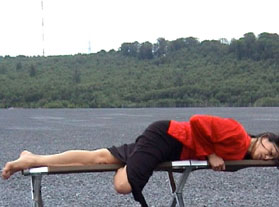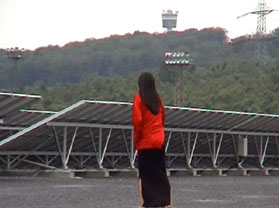Reflections
about the collaboration with Johannes Birringer in the projects ³Ensaio
sobre a Cegueira² (2004) an opera model and ³Canções dos Olhos²
(2005) a dance, digital image and music DVD.
Paradox:
there is something in your artistic conception that I really don't understand.
You write a lot about new digital forms of artistic creation, but you
emphasize "narrativity" and "fiction" in your artistic approach. This
happened in my opinion both in the opera and the DVD. In both collaborations,
I personally would have preferred a much more fragmented and disconnected
approach. I didn't want to tell stories at all, either in the opera
or in the DVD project.
I
was reviewing my first conception of the opera from April 2004. I proposed
to create individual virtual spaces and connect it through audio, video
and feedback. The opera should emerge as a network of relations of individuals
and objects in closed environments, defined as sound spaces. Them we
spent the first week struggling in the group about the conception and
in the second week we developed a conventional story-telling-musical-theater
enhanced with a couple of technological gestures, visual and acoustic
effects.
In the DVD project ³Intermedia Songs² it was my idea was to create an
invisible layer of narration emerging from the relationship between
sound, image and dance in the particular environment of the mine. But
what has been created is a linear story interpreted by one dancer acting
in the background of the mine and illustrated with music (and with the
sound track which you know eliminated). This is definitely something
very different from what I was expecting. And my critque on the "performance"
situation which has been created in the Interaktionslabor in agreement
with the participants, as you said is that we didn't worked at all
in the "interactivity".
The
main critique I have against the discourse of "digital interactivity",
including some theoretical issues that you defend in your writings,
is the lack of "content". Interactivity doesn't emerge from the use
of a particurlar technology, but as an embodiment of the creation process.
The paradigm of "interactivity", in my opinion, is the "chamber music".
Flusser talks about that in his book "Ins Universum der Technischen
Bilder" (1985). From the point of view of the system, there is no "interactivity"
between humans and it cannot exist any interactivity between humans
and machines, because they operate in different domains, which are operational
closed for each other. Interactivity is a Being-in-the-Word and not
an ensemble of devices or patches that we put together. Interactivity
is a form of synchronization of systems, which cannot distinguish between
perception and communication, and therefore they cannot communicate.
There is no possible communication between a human being and a computer;
only the system can communicate.
The
main issue of current artistic creation, in my opinion, is how to shape
a dialogue process between different kinds of systems; processes in
which the different systems operate as partners and not in a hierarchical
structure. That is the problem we have in the use of the current technology
by the society and particularly by artists. You see people making sounds
or dancing with cameras, sensors or whatever they want to use and doing
stupid things, because there is no dialogue between the systems operating
in that particular time and space. Either is the machine that dominates
the human being or the human being that uses the machine as a slave
for her/his purpose. In fact, we reproduce in our relationship with
technology the social and political patterns of oppression and exploitation
of the capitalist and imperialist systems.
There
is definitely a need of ethics and moral reflection in the "new" theories
of "digital phenomenology". "Interactivity" is mostly interpreted as
synonym of computer calculation and justified as projections for the
future. As Flusser says: "der futurisienden Computer hat die Zukunft
verschlungen. Futurisieren ist Zukunfsvernichtung mit dem Ziel, Katastrophen
zu verhüten" (1985: 173-174).
And Flusser says also: "Ich kann zwar Szenarios projizieren, welche
mein Voraussicht einer telematischen Geselschaft widerlegen; zum Beispiel
einen Nuklearkrieg oder einen Aufstand der Dritten Welt, oder, etws
rafinierter, den Zerfall eines so komplexen und darum labilen Systems,
wie es eine dialogische geschaltete Gesellschaft sein muß. Und ich kann
ein Szenario projizieren, in welchen sich die verdrängte Körperlichkeit
in der telematisierten Gesellschaft gegen die Zerebralisierung auflehnt,
um zu einer vorher nicht dagewesenen Bestialität zu führen" (1985: 174).
The
book has published 1985 and has a prophetic character. Since the 9/11
attacks against the Empire, technology development has been focused
on "security" against the global thread of terrorism. But it turns out,
that it doesn¹t protect us at all. Worst than that, it accelerates the
capability of self-destruction. See the powerful disintegration of the
US social system after the natural catastrophe of the hurricane Katrina.
This was only a small partial disintegration, but it shows very clearly
how fast the system can collapse. See also the development of robots
and uninhabited vehicles for replacing bodies in military conflicts.
There
is a strong tendency to make the body invisible through the development
of technologies that are suppose to protect us from the physical destruction.
The suicide bombers from Baghdad and Gaza Strip create also a dimension
of "invisibility" when their bodies are used as weapons for life destruction
and material damage. This kind of visibility is justified by the belief
in the superiority of a particular (religion) conception of God. The
former one, is justified by the belief on the superiority of the technology
that can make our bodies unattainable for our enemies, because the body
disappears behind the computer systems. Both invisibility are motivated
by the same kind of operations. And this is our problem.
|


